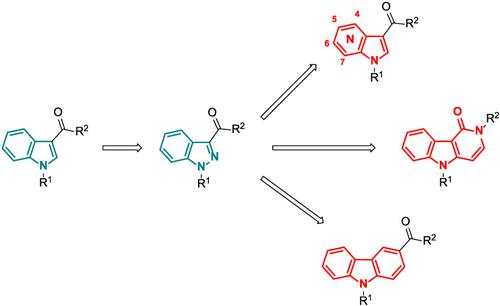当前位置:
X-MOL 学术
›
Drug Test. Anal.
›
论文详情
Our official English website, www.x-mol.net, welcomes your feedback! (Note: you will need to create a separate account there.)
Adding more "spice" to the pot: A review of the chemistry and pharmacology of newly emerging heterocyclic synthetic cannabinoid receptor agonists.
Drug Testing and Analysis ( IF 2.9 ) Pub Date : 2020-01-25 , DOI: 10.1002/dta.2752 Ryan M Alam 1, 2 , John J Keating 1, 2, 3
Drug Testing and Analysis ( IF 2.9 ) Pub Date : 2020-01-25 , DOI: 10.1002/dta.2752 Ryan M Alam 1, 2 , John J Keating 1, 2, 3
Affiliation

|
Synthetic cannabinoid receptor agonists (SCRAs) first appeared on the international recreational drug market in the early 2000s in the form of SCRA‐containing herbal blends. Due to the cannabimimetic effects associated with the consumption of SCRAs, they have acquired an ill‐informed reputation for being cheap, safe, and legal alternatives to illicit cannabis. Possessing high potency and affinity for the human cannabinoid receptor subtype‐1 (CB1) and ‐2 (CB2), it is now understood that the recreational use of SCRAs can have severe adverse health consequences. The major public health problem arising from SCRA use has pressed legislators around the world to employ various control strategies to curb their recreational use. To circumvent legislative control measures, SCRA manufacturers have created a wide range of SCRA analogs that contain, more recently, previously unencountered azaindole, γ‐carbolinone, or carbazole heterocyclic scaffolds. At present, little information is available regarding the chemical syntheses of these newly emerging classes of SCRA, from a clandestine perspective. When compared with previous generations of indole‐ and indazole‐type SCRAs, current research suggests that many of these heterocyclic SCRA analogs maintain high affinity and efficacy at both CB1 and CB2 but largely evade legislative control. This review highlights the importance of continued research in the field of SCRA chemistry and pharmacology, as recreational SCRA use remains a global public health issue and represents a serious control challenge for law enforcement agencies.
中文翻译:

向锅中添加更多“香料”:新兴的杂环合成大麻素受体激动剂的化学和药理学综述。
合成大麻素受体激动剂(SCRA)最初以含SCRA的草药混合物的形式出现在国际休闲药物市场上,发生于2000年代初期。由于食用SCRA的大麻仿制药效应,它们以便宜,安全和合法的大麻替代品而获得了不明智的声誉。对人类大麻素受体亚型-1(CB 1)和‐2(CB 2)具有很高的效力和亲和力),现在可以理解,休闲使用SCRA可能会对健康产生严重的不利影响。使用SCRA引起的主要公共卫生问题已迫使世界各地的立法者采用各种控制策略来遏制他们的娱乐用途。为了规避立法控制措施,SCRA制造商创建了各种各样的SCRA类似物,这些类似物最近包含以前从未遇到过的氮杂吲哚,γ-咔啉酮或咔唑杂环支架。目前,从秘密的角度来看,关于这些新兴的SCRA类的化学合成的信息很少。与前几代吲哚和吲唑型SCRA相比,当前的研究表明,这些杂环SCRA类似物中的许多在CB 1上均保持高亲和力和功效。和CB 2,但在很大程度上逃避了立法控制。这篇评论强调了在SCRA化学和药理学领域进行持续研究的重要性,因为休闲使用SCRA仍然是全球公共卫生问题,并且对执法机构提出了严峻的控制挑战。
更新日期:2020-01-25
中文翻译:

向锅中添加更多“香料”:新兴的杂环合成大麻素受体激动剂的化学和药理学综述。
合成大麻素受体激动剂(SCRA)最初以含SCRA的草药混合物的形式出现在国际休闲药物市场上,发生于2000年代初期。由于食用SCRA的大麻仿制药效应,它们以便宜,安全和合法的大麻替代品而获得了不明智的声誉。对人类大麻素受体亚型-1(CB 1)和‐2(CB 2)具有很高的效力和亲和力),现在可以理解,休闲使用SCRA可能会对健康产生严重的不利影响。使用SCRA引起的主要公共卫生问题已迫使世界各地的立法者采用各种控制策略来遏制他们的娱乐用途。为了规避立法控制措施,SCRA制造商创建了各种各样的SCRA类似物,这些类似物最近包含以前从未遇到过的氮杂吲哚,γ-咔啉酮或咔唑杂环支架。目前,从秘密的角度来看,关于这些新兴的SCRA类的化学合成的信息很少。与前几代吲哚和吲唑型SCRA相比,当前的研究表明,这些杂环SCRA类似物中的许多在CB 1上均保持高亲和力和功效。和CB 2,但在很大程度上逃避了立法控制。这篇评论强调了在SCRA化学和药理学领域进行持续研究的重要性,因为休闲使用SCRA仍然是全球公共卫生问题,并且对执法机构提出了严峻的控制挑战。


























 京公网安备 11010802027423号
京公网安备 11010802027423号